If your ideal summer vacation involves lounging on the beaches and admiring the sunsets of Greek islands like Santorini or Mykonos, remember that you’ll probably have to fly through Athens to get there. And why should you just sit around at the airport for your layover when the “birthplace of democracy” and one of the oldest cities in Europe is a short taxi ride away?
In June, I arrived in Greece with two family friends, and the three of us were all eager to see the crystal blue waters and enchanting white houses on the island of Naxos. However, that didn’t stop us from enjoying 48 hours in Athens first.
First off, most Athenians at restaurants, hotels, museums and shops speak English very well. However, if you have any food allergies (or other health issues), it’s always worth learning how to say and/or write your allergies in Greek in order to prevent any confusion and protect you from an accident.

We started our first day with the self-guided Athens City Walk, by travel writer Rick Steves. The tour gave us a brief introduction to Athenian architecture, historical figures, ruins, and central shopping streets, all at our own pace and with enough breaks amid the summer heat. Exploring the streets of Athens in the early and mid-morning or in the late afternoon/evening was the best choice, since the weather is cooler than at midday. Some points of interest from the tour include:
Syntagma Square: The tour began in Syntagma Square, which houses the colossal Greek Parliament building (the residence of the Greek royal family until 1934), the lovely National Gardens, and other beautiful buildings in different architectural styles. In front of the Parliament is the Tomb of the Unknown Soldier, which honors Greek soldiers who have died in war. Every hour, the changing of the guard is performed by members of the Presidential Guard, an elite Greek infantry unit clad in uniforms of the Greek War of Independence (from the Ottoman Empire) from 1821 to 1832. Watching the changing of the guard is both a great way to experience a historical and authentic Greek military march and to respect the country.
Hadrian’s Gate: Finished in 131 or 132 A.D., the Arch of Hadrian (referred to in Greek as “Hadrian’s Gate”), was built to celebrate the Roman emperor Hadrian, who was also a citizen of Athens. Through the ancient archway is the Temple of Olympian Zeus, which was completed during the reign of Hadrian. The site’s two columns and temple were constructed as an ode to Zeus, who was the leader of the Greek gods, and serve to tourists as a great preamble to visiting the Acropolis.
Byzantine Churches: Athens is speckled with small churches that were built in the 11th and 12th centuries when Greece was part of the Byzantine Empire (otherwise known as the Eastern Roman Empire). Each church is a concoction of ingeniously-shaped windows on jutting stone structures that are connected by red-tiled roofs and domes. Inside each church is an interior of marble columns, gilded paintings, and chandeliers. Peer into any church you pass in Greece, as each is an unique spectacle that offers some quiet from the touristy streets outside. The two churches that I especially loved were the Panaghia Kapnikarea Church on Ermou Street (the main shopping street in Athens) and Little Metropolis in the Mitropoleos Square.
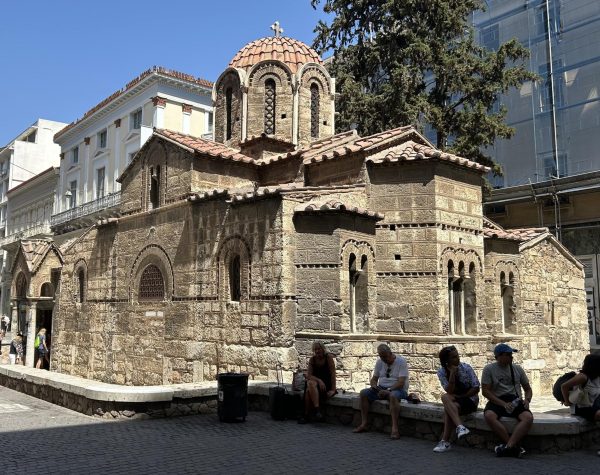
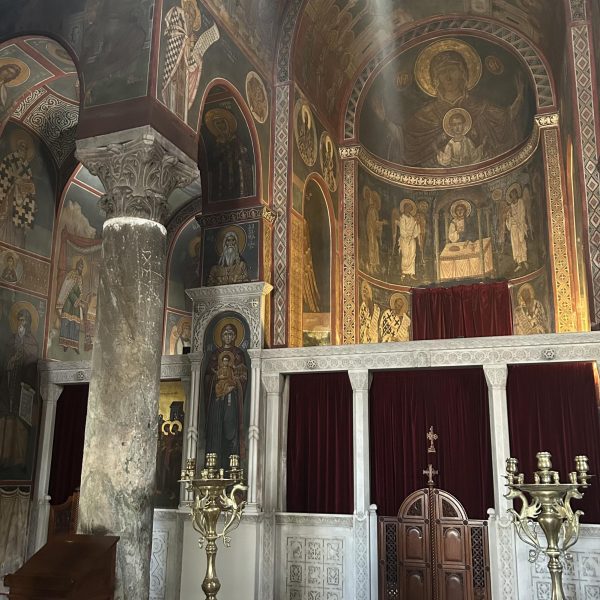
Metropolitan Cathedral of Athens: Also in Mitropoleos Square is the Metropolitan Cathedral of Athens, which is the Greek Orthodox church of the Archbishopric of Athens. Completed in 1862, the church’s interior is a treasure trove of arches, balconies, walkways, windows, and columns of marble, gold, and frescoes adorned with paintings and sparkling light fixtures. Outside the cathedral is a statue of Archbishop Damaskinos, the Archbishop of Athens during World War II who saved many Greek Jews during the Holocaust and led the Greek government from 1944 to 1946.

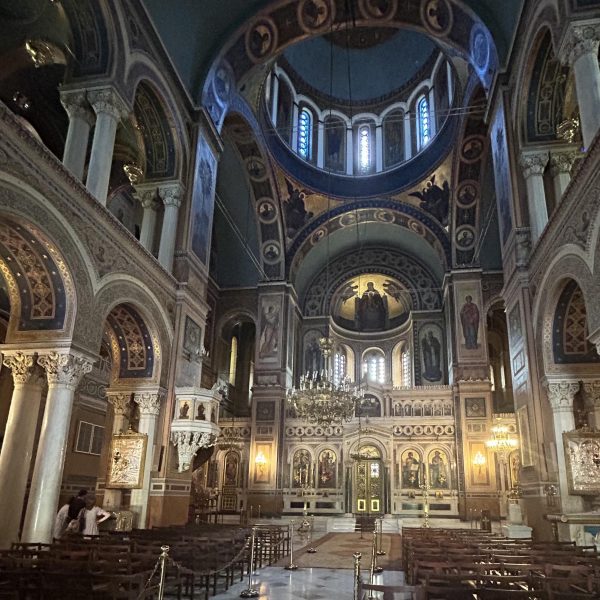
(Katherine Schick)
Adrianou Street: We finished our City Walk with a trot down Adrianou Street, which is filled with vendors of gelato, leather bags, hats, jewelry, clothes, and more. It’s the perfect place to find good-quality souvenirs and gifts.

In the afternoon, as the temperature hit its peak, we took refuge in the air-conditioned Acropolis Museum, which contains more than 4,250 objects from the Acropolis archeological site in Athens, which dates to the Greek Bronze Age. The museum is lined with intricate sculptures of Greek gods and historical figures, and the top floor is paneled with floor-to-ceiling windows that give entrancing city views. The museum also contains many signs that give an overview of Athenian history, which, as someone whose knowledge of ancient Greece starts and ends with the Percy Jackson books that I read when I was 9, was quite interesting.
Not every excavated object of the Acropolis can be found in the museum though. The Parthenon Marbles, which is a group of Greek sculptures from the Acropolis’s Parthenon temple, have been on display at the British Museum in London for the last couple hundred years. This is because the British government argued that the climate in Athens isn’t suitable for the sculptures. The argument in part led to the Greeks’ establishment of the modern Acropolis Museum, yet the Marbles still haven’t been returned to Athens. (Note: If you ever find yourself at the British Museum, the Parthenon Marbles are worth seeing.)
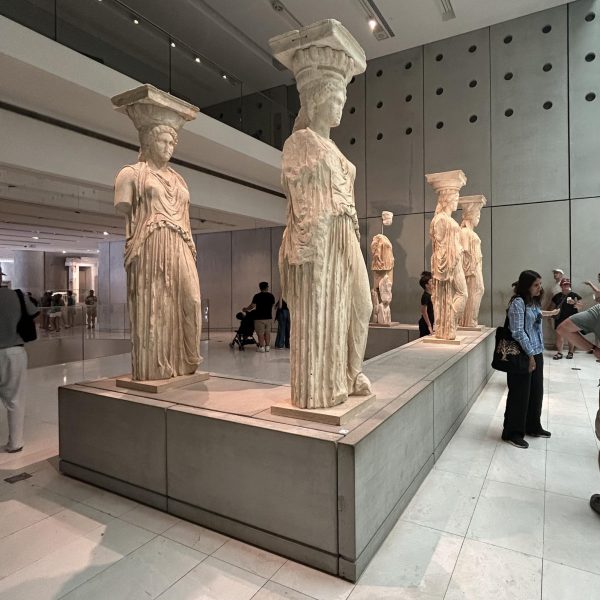
Acropolis: In the late afternoon, we took a tour of the Acropolis, which is the ancient site of structures such as the famous Parthenon temple and the Odeon of Herodes Atticus theater (which artists still perform in today!). Seeing the gigantic ruins, which are more than 2,000 years old, was one of the coolest and most special experiences of my life, and their locations atop a hill provided me with unforgettable views of Athens. I truly urge anyone who goes anywhere with ancient ruins to visit them. Visually, ruins are striking, and walking through a domain of the past is surreal and gives you a greater understanding of human history and development. In terms of the Acropolis, I recommend booking a tour, as you can gain helpful knowledge from the guides and you’ll be able to skip some lines. I also recommend visiting the Acropolis in the afternoon or evening. Not only is the temperature cooler, but the Acropolis isn’t as busy. (If you go in the morning, you’ll have to compete with hordes of people visiting from cruise ships docked in the city.)
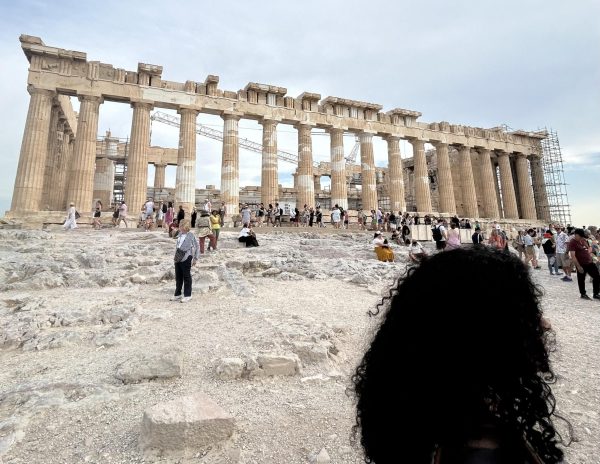
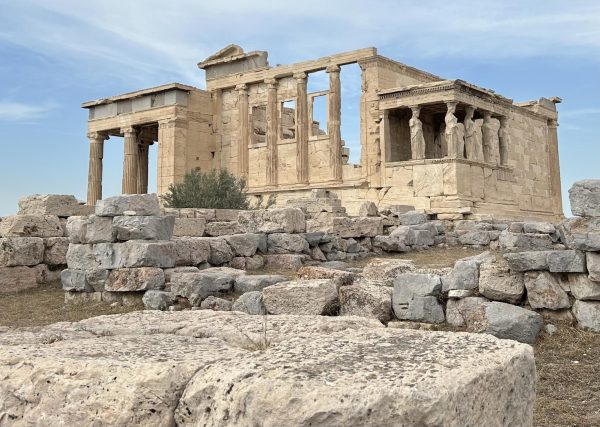
Food: We started our second and last day in Athens with a food tour. Food tours not only give you tastes of authentic food, but the guides lead you to different parts of the city and share facts about Greek culture and history. We took a tour through Athens Food on Foot that included stops at a coffee shop, cheese shop, meat market, and a restaurant with many different Greek plates. The organization handled my nut allergies very professionally so that I felt safe and supported, and I enjoyed meeting the other people on our tour. My favorite food that I ate was a Greek spinach and feta pie. I recommend taking a food tour in the morning, as it provides breakfast and lunch, and the weather won’t be as hot as in the afternoon.
My favorite streets that we crossed on the food tour were the Panepistimiou and Patission Streets, which are connected and lined with beautiful, classically-styled buildings that house luxury stores, the Cathedral of St. Dionysius, the National Archeological Museum and the Academy of Athens research institution. Whether you want to visit with a tour, to shop or stop at one of the buildings, or on a city walk, I recommend walking down these streets.

National Archaeological Museum: In the afternoon, we headed to the National Archaeological Museum on Patission Street to escape the sweltering sun. Unlike the Acropolis Museum, which only displays sculptures from the Acropolis, the National Archaeological Museum displays sculptures, jewelry, murals, skeletons, and other objects from across Greece, offering an overview of not just Athenian history but Greek history.
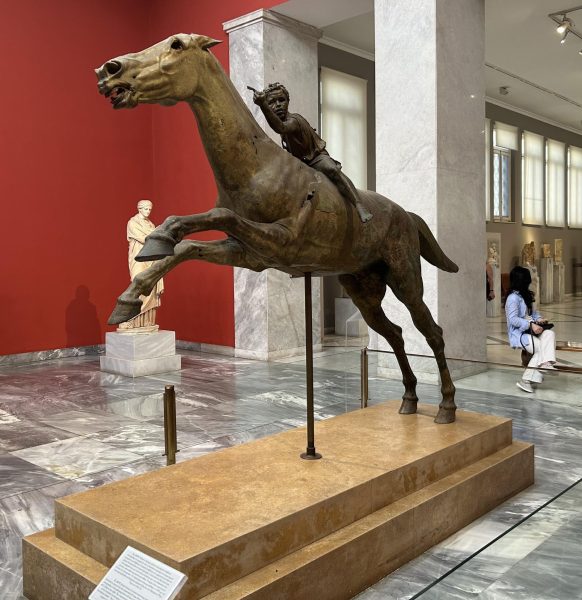
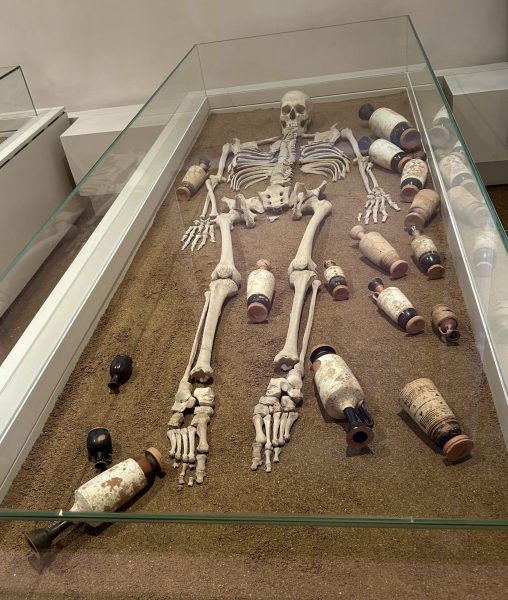
(Katherine Schick)
Shopping: My last activity in Athens was visiting the flea market on Aristogitonos Street, which sells everything vintage from photographs to lighters, jewelry, paintings, tableware, bags, instruments, toys, decor, and even a model pink Cadillac. If you don’t want to buy anything, it’s fun to just look around, but if you do spot something priceless and your negotiation skills are anything like mine, it can definitely be bargained down to a cheaper price.

Growing up, I was never interested in visiting Athens, but I really should’ve been. Unlike London, Disney World, and the other places I used to dream about, Athens has ruins from the origins of Western civilization with incredibleness that still hasn’t sunk in. The ruins and museums also taught me about past cultures and how humanity has evolved, which I consider to be enriching and invaluable knowledge. In Athens I met kind people, ate delicious food, and soaked up the city’s lively energy. And now that I’m back in Boston, lighting candles has been so much easier with the 1950s lighter that I bargained for at the flea market.
One last tip: If you ever have the privilege to be in Athens, try to catch a glimpse of the Acropolis at night. It was a sight so captivating that I forgot to take a photo.
–July 27, 2024–







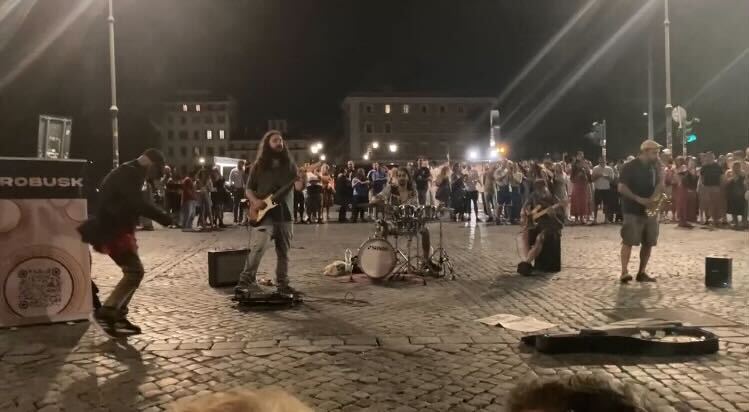

Ann Pugliese • Jul 28, 2024 at 11:15 pm
Oh, thank you Katherine! This takes me back to my first college course, Ancient Greek Literature, taught by Sister Maris Stella! I can still hear her voice telling us about the Greek gods, and Agamemnon. So glad that you could share your excursion and talent with us.
Ann P.